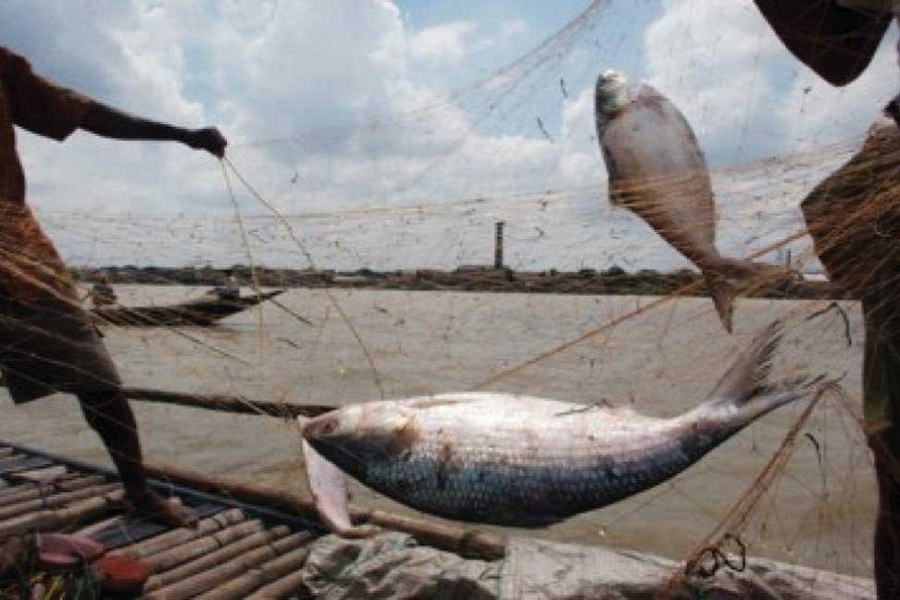
Published :
Updated :

Every year millions of fish migrate to their native habitat. Migration is a peculiar kind of population dispersion among fishes.
Migrations involve the fish moving from one part of a water body to another on a regular basis. In some migration, adult fishes live in the sea and migrate to fresh water to spawn. In other situations, the opposite happens. Some migratory fishes are salmon, smelt, shad, striped bass, most of the eel species, tuna and Hilsha.
Fishes migrate to their spawning and rearing habitats to reproduce. Some fish need to swim thousands of miles through oceans and rivers to reach these freshwater destinations. If the migrations of fishes are blocked, they cannot grow in population.
Marine forage fish often make large migrations between their spawning, feeding and nursery grounds. Movements are associated with ocean currents and with the availability of food in different areas at different times of the year. Movements of fish in fresh water also occur; often the fish swim upriver to spawn.
Hilsas migrate to estuarine and fresh waters for spawning purposes. Peak upstream migration of Hilsa in the rivers of Bangladesh mostly starts with the onset of southwest monsoon. Tagging experiments have shown that a Hilsa may cover as much as 70.8 kilometres in one day. During the peak breeding season in Bangladesh waters, the adult fishes run in shoals to the estuaries and the rivers. They migrate upstream as much as 1,200 km (usual run 50-100 km) for spawning.
Over the last few decades, the quantity of the fish has suffered rapid depletion in the riverine environment of many countries. Experts have blamed rapid siltation and other degraded ecological conditions including wanton destruction of Jatka (Juveniles). The persistent problem led many governments, including Bangladesh's, to formulate and implement a good management plan to sustain the population of the fish.
In Bangladesh, the timing for migration starts around early September with a peak in October to early November. The migration is highly related to the state of sexual maturity, and the volume of freshwater input through river discharge and run-off into the sea during the monsoon season (June-September) and onwards. Some other factors such as current velocity, temperature, salinity, turbidity, primary productivity and availability of planktonic food also influence the movement of Hilsa fishes from the sea into the river. It is thus logical to conclude that the hilsa population from the northern Bay of Bengal primarily inhabits marine waters and migrates to freshwater for spawning. Hilsa as a single species accounts for 12 per cent of the total marine catches. About two per cent people of the country are directly or indirectly engaged with Hilsa fishing. Particularly large stocks are found in upper Bay of Bengal region sustained by the large river systems. The global hilsa catch is reportedly 75 per cent from Bangladesh waters, 15 per cent from Myanmar, five per cent from India and five per cent from other countries such as Thailand and Iran. It is clear that Bangladesh has the highest Hilsa catch in the world. The country also exports Hilsa to other countries of the world earning foreign currency. This is why it is important to ensure that the population of Hilsa is maintained at an optimum level.
Hilsa migration is usually disturbed by various anthropogenic activities, climate change effects, increased siltation and rising of the river basins. Human-made barriers like dams and culverts as well as oceanographic changes like high turbidity that increases flooding, tidal action and salinity, can also deter hilsa migration.
Hilsa fecundity ranges from 1.5 to 2.0 million eggs for fish ranging in length from 35 to 50 cm. Hilsa fecundity is declining in different areas due to climate change.
Additionally, the survival rate of juvenile hilsa is under threat due to shifting of the spawning grounds in the lower zone. Construction and development work near the rivers and the resultant waste being dumped into the water-bodies are also affecting Hilsas. Many projects are underway in Khulna and other parts of the country. Once these projects are completed, the movement of Hilsa from the Bay of Bengal to the rivers within Bangladesh are likely to be disrupted according to experts of fishers.
If necessary and timely steps are taken by the authorities, then the population of the prized Hilsa can still be kept at an optimal level in the country throughout the year.
Nushrat Bithy is a student at the fisheries and marine science department, Noakhali Science and Technology University.


 For all latest news, follow The Financial Express Google News channel.
For all latest news, follow The Financial Express Google News channel.